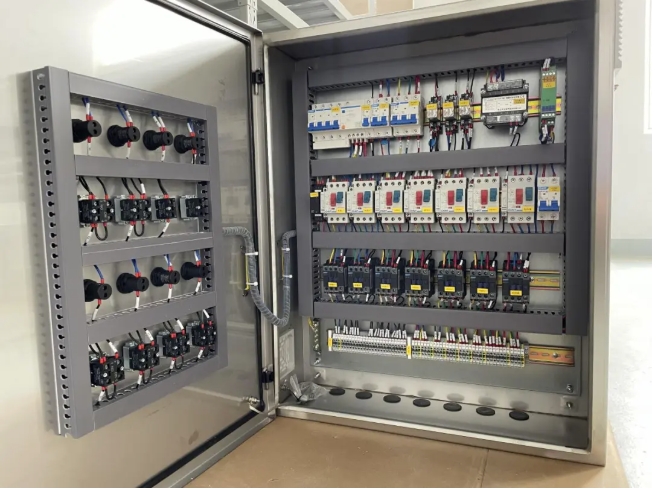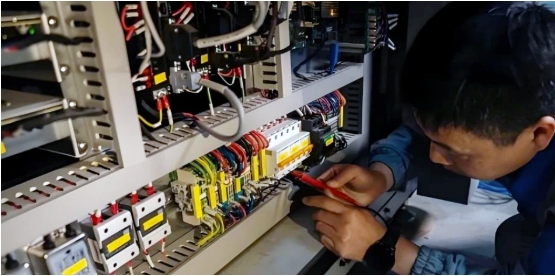Electrical Safety: Daily Maintenance and Care of On-Site Electrical Distribution Boxes
Return to ListIn modern pig farms, environmental control technology utilizes intelligent equipment and systems to monitor and optimize breeding conditions in real time, enhancing both farming efficiency and livestock health. Electrical installations—particularly distribution and control panels—play a critical role in ensuring stable power supply and operational safety. Regular maintenance and servicing of these electrical panels help prevent power failures, equipment damage, and potential hazards, thereby safeguarding uninterrupted and secure farm operations.

Basic Components and Functions of Electrical Distribution Panels
Electrical distribution panels typically consist of the following components:
Circuit Breakers
Function as switching devices to control circuits
Automatically cut off power in case of overloads
Contactors & Relays
Enable start/stop control of equipment
Provide remote operation capabilities
Cables & Wiring
Conduct electrical power transmission
Connect power sources to equipment
Meters & Protective Devices
Monitor electricity consumption
Safeguard equipment from abnormal current conditions (e.g., surges, short circuits)
Grounding Systems
Ensure electrical safety by providing earthing protection
Prevent electric shock hazards by dissipating fault currents

Main Functions of Electrical Distribution Panels
Power Distribution & Control
Distribute electricity to various farming equipment as required
Enable centralized management of power allocation
Safety Protection
Instantaneously cut off power during circuit failures
Prevent electrical fires and equipment damage
Incorporate overload/short-circuit protection mechanisms
Power Monitoring
Track real-time electricity consumption
Monitor operational status of connected devices
Provide early warning for abnormal conditions

Daily Inspection and Maintenance of Electrical Panels
1. Monthly External Inspection
Perform visual checks at least once per month:
Enclosure Integrity
Inspect for cracks, dents or deformations
Ensure complete sealing to prevent moisture/dust/vermin ingress
Door Mechanism
Verify smooth operation of hinges and locks
Confirm proper sealing when closed
Surface Cleaning
Wipe surfaces with dry lint-free cloth
Remove contaminants affecting heat dissipation
2. Quarterly Internal Inspection
Conduct thorough checks every 3 months (with power disconnected):
Connection Security
Tighten all terminal connections to specified torque
Check for signs of arcing or discoloration
Protective Devices
Test circuit breakers' trip functionality
Verify contactor engagement/disengagement
Exercise manual operation switches
Wiring Condition
Replace any cracked/brittle insulation immediately
Look for thermal damage (discolored/melted components)
Component Verification
Test relay coil resistance and contact continuity
Confirm meter calibration validity
Check fuse ratings match circuit design

3. Bi-Annual Grounding System Inspection
Conduct comprehensive grounding checks every 6 months:
Grounding Connection Verification
Visually inspect all grounding conductor terminations
Confirm tightness with calibrated torque wrench (recommended 17-20 N·m for standard terminals)
Check for corrosion at connection points; apply antioxidant compound if needed
Ground Resistance Testing
Perform fall-of-potential test per IEEE Std 81
Maintain resistance below 5Ω for livestock facilities (NFPA 70 Article 547 requirement)
Document test results for compliance records
4. Bimonthly Cleaning Protocol
Execute thorough cleaning every 60 days:
De-energized Cleaning Procedure
Class II ESD-safe vacuum for bulk dust removal
Nylon-bristle brushes (width ≤25mm) for component cleaning
Implement LOTO (Lockout-Tagout) procedure before accessing panel
Remove debris using:
Apply electronic-grade isopropyl alcohol (70-90% concentration) for stubborn deposits
Prohibited Practices
× No compressed air (>15 psi) that may drive particles deeper
× No aqueous cleaning methods that risk IP rating compromise
× No abrasive materials that may damage component coatings
The electrical distribution box plays a pivotal role in aquaculture facilities, with its routine maintenance directly impacting operational safety and equipment efficiency. Through systematic measures such as periodic inspections, cleaning, cable fastening, and ensuring proper grounding protection, the service life of the electrical distribution box can be significantly extended while preventing potential malfunctions and safety hazards. Regular maintenance and inspections not only guarantee the proper functioning of the electrical distribution box but also mitigate the risk of major safety incidents. Consequently, aquaculture facility managers should accord paramount importance to the maintenance of electrical distribution boxes, ensuring that all operations strictly adhere to standardized procedures.
If you also have a need for aquaculture equipment,
Welcome to consult.
Please call 0532-68013396.
